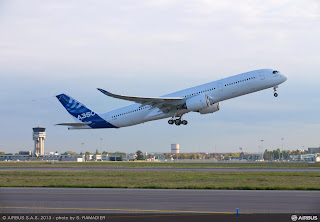In the era where increased incidents and accidents are attributed to flight crew non-adherence to procedures, what can be done to ensure increased SOP compliance?
Showing posts with label SAFETY. Show all posts
Showing posts with label SAFETY. Show all posts
Saturday, November 16, 2013
Increasing SOP Compliance
Srinivas Rao | 12:27 AM |
A320
|
A330
|
A340
|
A350
|
A380
|
AIRBUS
|
procedures
|
SAFETY
|
SOP
|
STANDARDS
|
TASKS
|
TRAINING


Saturday, November 9, 2013
AIRCRAFT GO-AROUND MANEUVER
Srinivas Rao | 3:11 AM |
A330
|
A350
|
AIRBUS
|
AIRCRAFT
|
crew
|
DECISON MAKING
|
GO AROUND
|
procedures
|
SAFETY
|
TRAINING


One question that is frequently asked in aviation circles about piloting issue is as to why a go-around was not carried out when the approach was unstable.
What is it that makes a well trained and proficient crew shy
away from conducting a go-around on the approach when it is required so??
Labels:
A330,
A350,
AIRBUS,
AIRCRAFT,
crew,
DECISON MAKING,
GO AROUND,
procedures,
SAFETY,
TRAINING
Thursday, December 22, 2011
RUNWAY INCURSION
A runway
incursion is an incident where an unauthorized aircraft, vehicle or person
is on a runway. This adversely affects runway safety, as it creates the risk
that an airplane taking off or landing will collide with the object. It is defined by ICAO as Any occurrence at
an aerodrome involving the incorrect presence of an aircraft, vehicle, or
person on the protected area of a surface designated for the landing and
take-off of aircraft.
A major disaster was averted at the CSI
Airport , Mumbai last year after an aircraft, which was supposed to be on the taxiway,
entered the runway area, while another had been cleared to land.
These close
calls between aircraft and other planes, ground vehicles and hazards have grown
steadily over the years and are now a grave concern for safety officials across
the world.
An effective
Runway incursion prevention program should be capable of
·
Alerting
the pilots to conflicting traffic in the air and on the runways, taxiways and
ramps;
·
Allowing
more aircraft to land safely on time in bad weather
·
Improving
communication between pilots and air traffic controllers ; and
·
Virtually
eliminating the world’s greatest cause of aviation fatalities – controlled flight
into terrain or CFIT.
Please offer
your comments experiences and suggestions.
Labels:
EXCURSION,
PREVENTION,
procedures,
RUNWAY INCURSION,
SAFETY
Tuesday, December 20, 2011
RED STOP BAR AND SAFETY ENHANCEMENT
Red stop bar is one row of flush-mounted unidirectional red
lights installed across a taxiway with a 3m spacing to designate a runway
–holding position or intersection/taxiway holding position.
To prevent runway incursions, crew need to be trained and
instilled in adopting a disciplined approach in not crossing the red stop bar
even if ATC clearance is accorded.
Even in some cases where conditional taxi clearances are
given by ATC such as “cleared to lineup after the landing aircraft”, the taxi
shall be commenced only if the red stop bar light is off and the green centre
lights are switched on.
This is akin the red signal of the traffic light where the
traffic comes to a standstill. This holds good for operations in any part of
the world.
Good habit forming and disciplined procedural approach is the key to enhancing safety.
Labels:
AERODROME LIGHTING,
AERODROME STANDARDS,
RED STOP BAR,
SAFETY
Saturday, November 19, 2011
AUTOMATION -- Automation in the Cockpit
Srinivas Rao | 12:45 PM |
ACCIDENT
|
AUTOMATION
|
CRM
|
PROCEDURE
|
SAFETY
|
TASK SHARING
|
TRAINING


Is Automation in cockpit a boon or bane???
Increased automation in cockpits has changed radically how
our cockpits look and work is carried on.
Either the automation is either too complex for human
operators to comprehend, or is the information in the manuals inadequate, or is
it the automation integration that seems to be the problem, or is it the lack
of enough emphasis on the use of automation in the training curriculum the
problem, or is it the complacency that sets in with overuse of automation and skills
degeneration with overuse of automation the problem, or is the problem with
operating procedures not adequately
addressing the use of automation in cockpits???
Send in your views
Labels:
ACCIDENT,
AUTOMATION,
CRM,
PROCEDURE,
SAFETY,
TASK SHARING,
TRAINING
FLIGHT PROCEDURES-- Runway Veer-- Off
What is Runway Veer-off??
Runway veer-off is runway excursion in which an aircraft
departs the side of the runway during take-off or landing.
a. WEATHER
b. CREW TECHNIQUE/DECISION
c. AIRCRAFT SYSTEMS
WEATHER
Runway Condition, Wet or Contaminated, Severe Wind, Cross
wind , Windshear, Reverse thrust effect in a crosswind
and on Wet/Contaminated runway
CREW TECHNIQUE/DECISION
Use on Nose Wheel Steering at higher speeds
Airspeed too fast on runway to exit
Incorrect Cross wind landing technique--- a) Drifting during transition from a wings
level crosswind approach(crabbed approach) to a steady-sideslip crosswind
approach ,or failing to transition from a wings level approach to a
steady-sideslip approach(decrab) in strong crosswind conditions.
AIRCRAFT SYSTEMS
• Asymmetric thrust
• Non-deployment of speed brakes • Uncommanded differential braking
The runway veer-off is usually a result of one or more of
above factors.
Following the company promulgated procedures, limitations,
techniques; etc. will help in mitigating or managing the excursions.
Labels:
PROCEDURE,
RUNWAT VEER OFF,
RUNWAY EXCURSION,
SAFETY,
TRAINING
Subscribe to:
Comments (Atom)






